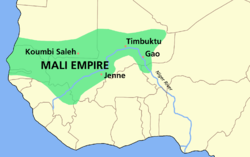Mali Empire
| Mali Empire | ||||||||||||||||||
|
Nyeni (Bambara) after c. 1230: Mande Kurufaba (Bambara) |
||||||||||||||||||
|
||||||||||||||||||
|
Extent of the Mali Empire (c. 1350)
|
||||||||||||||||||
| Capital | Niani; later Ka-ba | |||||||||||||||||
| Languages | Malinké, Mandinka, Malinke, Fulani, Bozo | |||||||||||||||||
| Religion | African Traditional Religion, Islam | |||||||||||||||||
| Political structure | Empire | |||||||||||||||||
| Mansa (Emperor) | ||||||||||||||||||
| • | 1235–1255 | Mari Djata I (first) | ||||||||||||||||
| • | c. 17th century | Mahmud IV (last) | ||||||||||||||||
| Legislature | Gbara | |||||||||||||||||
| Historical era | Postclassical Era | |||||||||||||||||
| • | Established | c. 1235 | ||||||||||||||||
| • | Capital moved from Niani to Kangaba | 1559 | ||||||||||||||||
| • | State collapses and divided among emperor's sons | c. 1600 | ||||||||||||||||
| Area | ||||||||||||||||||
| • | 1250 | 100,000 km² (38,610 sq mi) | ||||||||||||||||
| • | 1312 | 1,294,994 km² (500,000 sq mi) | ||||||||||||||||
| • | 1380 | 1,100,000 km² (424,712 sq mi) | ||||||||||||||||
| • | 1500 | 400,000 km² (154,441 sq mi) | ||||||||||||||||
| Currency |
Gold dust (Salt, copper and cowries were also common in the empire) |
|||||||||||||||||
|
||||||||||||||||||
| Today part of |
|
|||||||||||||||||
| National Symbol: Falcon Sacred Animal:Falcon and numerous other animals according to each of the governing clans (Lion etc.) |
||||||||||||||||||
The Mali Empire (Manding: Nyeni; English: Niani), also historically referred to as the Manden Kurufaba, was an empire in West Africa from c. 1230 to c. 1600. The empire was founded by Sundiata Keita and became renowned for the wealth of its rulers, especially Mansa Musa. The Manding languages were spoken in the empire.
The Mali Empire was the largest in West Africa and profoundly influenced the culture of West Africa through the spread of its language, laws and customs.
Rock art in the Sahara suggests that northern Mali has been inhabited since 10,000 BC, when the Sahara was fertile and rich in wildlife. By 300 BC, large organised settlements had developed, most notable near Djenné, one of West Africa's oldest cities. By the 6th century AD, the lucrative trans-Saharan trade in gold, salt and slaves had begun, facilitating the rise of West Africa's great empires.
There are a few references to Mali in early written literature. Among these are references to "Pene" and "Malal" in the work of al-Bakri in 1068, the story of the conversion of an early ruler, known to Ibn Khaldun (by 1397) as Barmandana, and a few geographical details in the work of al-Idrisi.
In the 1960s, archaeological work at Niani village, reputed to be the capital of Mali, by Polish and Guinean archaeologists revealed the remains of a substantial town dating back as far as the 6th century.
Modern oral traditions also related that the Mandinka kingdoms of Mali or Manden had already existed several centuries before Sundiata's unification as a small state just to the south of the Soninké empire of Wagadou, better known as the Ghana Empire. This area was composed of mountains, savannah and forest providing ideal protection and resources for the population of hunters. Those not living in the mountains formed small city-states such as Toron, Ka-Ba and Niani. Through the oral tradition of Griots, The Keita dynasty from which nearly every Mali emperor came traces its lineage back from Lawalo, one of the sons of Bilal, the faithful muezzin of Islam's prophet Muhammad, which was said to have migrated into Mali and his descendants establishing the ruling Keita Dynasty through Maghan Kon Fatta, father of Sundiata Keita.
...
Wikipedia

